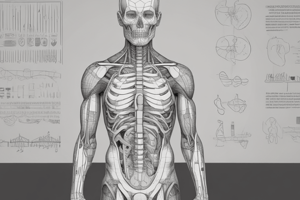Podcast
Questions and Answers
What is the origin of the muscle that stabilizes the vertebral column and extends and rotates the spine?
What is the origin of the muscle that stabilizes the vertebral column and extends and rotates the spine?
- Vertebral bodies
- Ribcage
- Transverse processes of vertebrae (correct)
- Spines of the vertebrae
What is the action of the bilateral contraction of the muscle that stabilizes the vertebral column?
What is the action of the bilateral contraction of the muscle that stabilizes the vertebral column?
- Flexion of the spine
- Elevation of the ribs
- Extension of the spine (correct)
- Lateral flexion and rotation of the vertebral column
What is the name of the muscle that spans between adjacent spinous processes?
What is the name of the muscle that spans between adjacent spinous processes?
- Interspinalis (correct)
- Rotators
- Levators costarum
- Intertransversari
What is the nerve supply of the muscle that rotates the vertebral column?
What is the nerve supply of the muscle that rotates the vertebral column?
What is the insertion of the muscle that stabilizes the vertebral column and extends and rotates the spine?
What is the insertion of the muscle that stabilizes the vertebral column and extends and rotates the spine?
What is the action of the levators costarum muscle?
What is the action of the levators costarum muscle?
What is the function of the intertransversari muscle?
What is the function of the intertransversari muscle?
What is the name of the muscle that stabilizes the vertebral column and extends and rotates the spine?
What is the name of the muscle that stabilizes the vertebral column and extends and rotates the spine?
What is the action of the unilateral contraction of the muscle that stabilizes the vertebral column?
What is the action of the unilateral contraction of the muscle that stabilizes the vertebral column?
What is the origin of the levators costarum muscle?
What is the origin of the levators costarum muscle?
Flashcards
Thoracolumbar Fascia
Thoracolumbar Fascia
A large, diamond-shaped area of connective tissue surrounding the intrinsic back muscles, formed by the deep fascia of the thoracic and lumbar regions.
Intrinsic Back Muscles
Intrinsic Back Muscles
A group of muscles located deep to the superficial muscles, responsible for movement and stabilization of the vertebral column.
Erector Spinae
Erector Spinae
The three muscle columns that form the erector spinae: Spinalis, Longissimus, and Iliocostalis. They extend, rotate, and laterally flex the vertebral column.
Longissimus
Longissimus
Signup and view all the flashcards
Spinalis
Spinalis
Signup and view all the flashcards
Semispinalis
Semispinalis
Signup and view all the flashcards
Multifidus
Multifidus
Signup and view all the flashcards
Transversospinales
Transversospinales
Signup and view all the flashcards
Transversospinales Muscles
Transversospinales Muscles
Signup and view all the flashcards
Superficial Extrinsic Back Muscles
Superficial Extrinsic Back Muscles
Signup and view all the flashcards
Study Notes
Muscles of the Back
- Divided into extrinsic and intrinsic back muscles
- Intrinsic muscles are located deep to the extrinsic muscles, separated by the thoracolumbar fascia
Extrinsic Muscles of the Back
- Superficial extrinsic muscles:
- Trapezius
- Latissimus dorsi
- Rhomboid major
- Rhomboid minor
- Levator scapulae
- Intermediate extrinsic muscles:
- Serratus posterior superior
- Serratus posterior inferior
- Serratus posterior muscles:
- Span from vertebrae to ribs
- Serratus posterior superior:
- Origin: nuchal ligament and spines C7-T3
- Insertion: ribs 2-5
- Nerve supply: intercostal nerves
- Action: assists breathing by elevating ribs during inspiration
- Serratus posterior inferior:
- Origin: spines of vertebrae T11-L2
- Insertion: ribs 9-12
- Nerve supply: intercostal nerves
- Action: assists breathing by depressing ribs during expiration
Thoracolumbar Fascia
- A large, diamond-shaped area of connective tissue
- Constituted by the thoracic and lumbar parts of the deep fascia
- Encloses the intrinsic back muscles
- Serves as an attachment site for various muscles of the back
Intrinsic Muscles of the Back
- Classified into:
- Superficial intrinsic muscles
- Intermediate intrinsic muscles
- Deep intrinsic muscles
Superficial Intrinsic Muscles
- Splenius capitis:
- Origin: nuchal ligament and spines C7-T3
- Insertion: mastoid process and occipital bone of the skull
- Nerve supply: posterior rami of cervical spinal nerves
- Actions:
- Bilaterally: extends the head and neck
- Unilaterally: lateral flexion and rotation of the neck
- Splenius cervicis:
- Origin: spines of T3-T6 vertebrae
- Insertion: transverse processes of C1-3
- Nerve supply: posterior rami of the cervical spinal nerves
- Actions:
- Bilaterally: extends the head and neck
- Unilaterally: lateral flexion and rotation of the neck
Intermediate Intrinsic Muscles
- Iliocostalis, longissimus, and spinalis (I Like Standing)
- Form a column known as the erector spinae
- Situated between the vertebral spinous processes and the costal angle of the ribs
- Common tendinous origin:
- Lumbar and lower thoracic vertebrae
- Sacrum
- Posterior aspect of iliac crest
- Sacroiliac and supraspinous ligaments
- Nerve supply: posterior rami of the spinal nerves
- Actions:
- Bilaterally: extends the vertebral column and head
- Unilaterally: laterally flexes the vertebral column
- Iliocostalis:
- Located laterally within the erector spinae
- Associated with the ribs
- Divided into three parts: lumborum, thoracis, and cervicis
- Origin: common tendinous origin
- Insertion: attaches to the costal angle of the ribs and the cervical transverse processes (C3-7)
- Longissimus:
- Situated between the iliocostalis and spinalis
- Largest of the three columns
- Divided into three parts: thoracic, cervicis, and capitis
- Origin: common tendinous origin
- Insertion: lower ribs, the transverse processes of C2-T12, and the mastoid process of the skull
- Spinalis:
- Located medially within the erector spinae
- Smallest of the three muscle columns
- Divided into three parts: thoracis, cervicis, and capitis (although the cervicis part is absent in some individuals)
- Origin: common tendinous origin
- Insertion: spines of C2-T8 and the occipital bone of the skull
Deep Intrinsic Muscles
- Located underneath the erector spinae
- Known collectively as the transversospinales
- A group of short muscles, associated with the transverse and spinous processes of the vertebral column
- Three major muscles in this group:
- Semispinalis
- Multifidus
- Rotators
- Semispinalis:
- Most superficial of the deep intrinsic muscles
- Divided by its superior attachments into thoracic, cervicis, and capitis
- Origin: transverse processes of C4-T10
- Insertion: spines of 5-6 above its origin, and to the occipital bone of the skull
- Nerve supply: posterior rami of the spinal nerves
- Actions:
- Extends and rotates the head and vertebral column
- Multifidus:
- Located underneath the semispinalis muscle
- Best developed in the lumbar area
- Origin:
- Transverse processes of vertebrae
- Posterior aspect of sacrum
- Posterior superior iliac spine (PSIS) of ilium
- Posterior sacroiliac ligament
- Insertion: spines of the vertebrae 3-4 levels above origin
- Nerve supply: posterior rami of the spinal nerves
- Actions:
- Stabilizes the vertebral column
- Bilateral contraction: extension of spine
- Unilateral contraction: lateral flexion and rotation of vertebral column
- Rotators:
- Most prominent in the thoracic region
- Origin: from the vertebral transverse processes
- Insertion: to the spine of the immediately superior vertebrae
- Nerve supply: posterior rami of the spinal nerves
- Action: stabilizes the vertebral column, extension and rotation of vertebral column
Minor Deep Intrinsic Muscles
- Interspinalis: spans between adjacent spinous processes, acts to stabilize the vertebral column
- Intertransversari: spans between adjacent transverse processes, acts to stabilize the vertebral column
- Levators costarum: originates from the transverse processes of vertebrae and attaches to the rib immediately below, acts to elevate the ribs
Studying That Suits You
Use AI to generate personalized quizzes and flashcards to suit your learning preferences.





